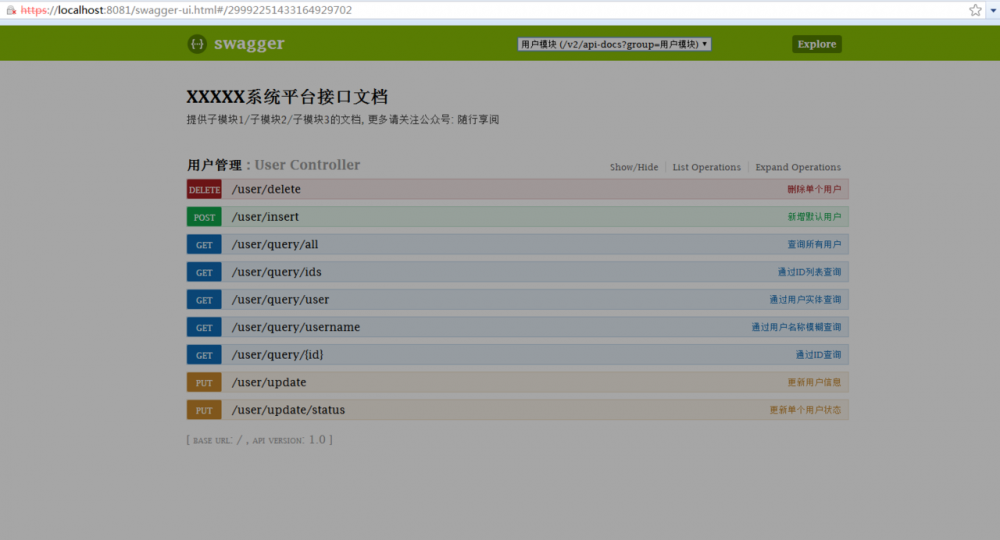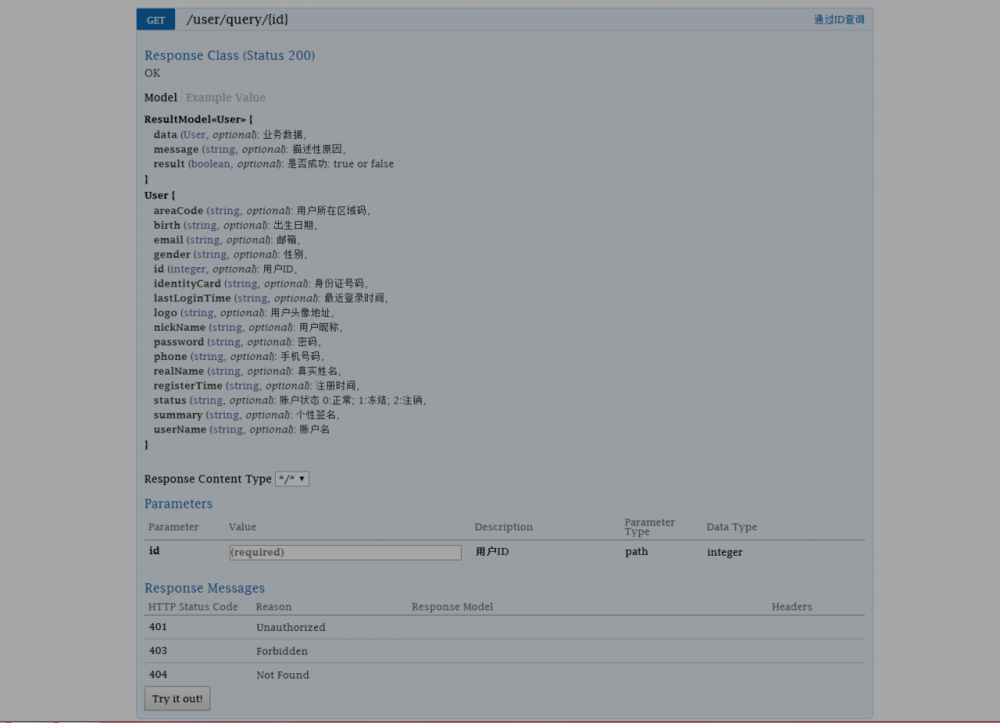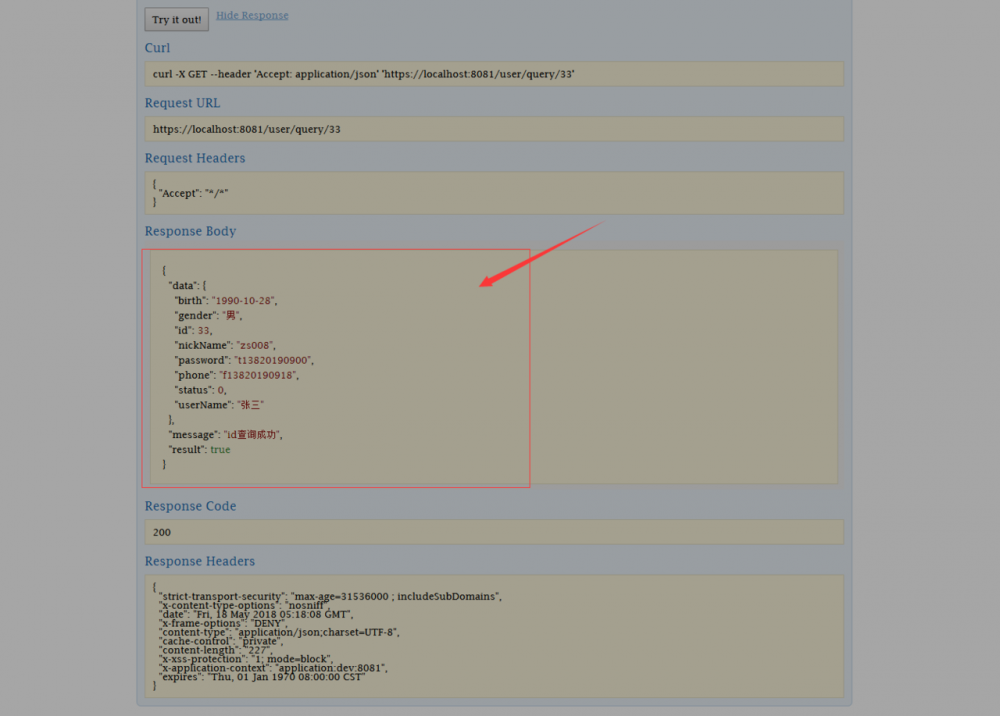Java效率工具之Swagger2
现代化的研发组织架构中,一个研发团队基本包括了产品组、后端组、前端组、APP端研发、测试组、UI组等,各个细分组织人员各司其职,共同完成产品的全周期工作。如何进行组织架构内的有效高效沟通就显得尤其重要。其中,如何构建一份合理高效的接口文档更显重要。
接口文档横贯各个端的研发人员,但是由于接口众多,细节不一,有时候理解起来并不是那么容易,引起‘内战’也在所难免, 并且维护也是一大难题。
类似RAP文档管理系统,将接口文档进行在线维护,方便了前端和APP端人员查看进行对接开发,但是还是存在以下几点问题:
- 文档是接口提供方手动导入的,是静态文档,没有提供接口测试功能;
- 维护的难度不小。
Swagger的出现可以完美解决以上传统接口管理方式存在的痛点。本文介绍Spring Boot整合Swagger2的流程,连带填坑。
使用流程如下:
1)引入相应的maven包:
<dependency> <groupId>io.springfox</groupId> <artifactId>springfox-swagger2</artifactId> <version>2.7.0</version> </dependency> <dependency> <groupId>io.springfox</groupId> <artifactId>springfox-swagger-ui</artifactId> <version>2.7.0</version> </dependency>
2)编写Swagger2的配置类:
package com.trace.configuration;
import io.swagger.annotations.Api;
import org.springframework.beans.factory.annotation.Value;
import org.springframework.context.annotation.Bean;
import org.springframework.context.annotation.Configuration;
import springfox.documentation.builders.ApiInfoBuilder;
import springfox.documentation.builders.PathSelectors;
import springfox.documentation.builders.RequestHandlerSelectors;
import springfox.documentation.service.ApiInfo;
import springfox.documentation.spi.DocumentationType;
import springfox.documentation.spring.web.plugins.Docket;
import springfox.documentation.swagger2.annotations.EnableSwagger2;
/**
* Created by Trace on 2018-05-16.<br/>
* Desc: swagger2配置类
*/
@SuppressWarnings({"unused"})
@Configuration @EnableSwagger2
public class Swagger2Config {
@Value("${swagger2.enable}") private boolean enable;
@Bean("用户模块")
public Docket userApis() {
return new Docket(DocumentationType.SWAGGER_2)
.groupName("用户模块")
.select()
.apis(RequestHandlerSelectors.withClassAnnotation(Api.class))
.paths(PathSelectors.regex("/user.*"))
.build()
.apiInfo(apiInfo())
.enable(enable);
}
@Bean("客户模块")
public Docket customApis() {
return new Docket(DocumentationType.SWAGGER_2)
.groupName("客户模块")
.select()
.apis(RequestHandlerSelectors.withClassAnnotation(Api.class))
.paths(PathSelectors.regex("/custom.*"))
.build()
.apiInfo(apiInfo())
.enable(enable);
}
private ApiInfo apiInfo() {
return new ApiInfoBuilder()
.title("XXXXX系统平台接口文档")
.description("提供子模块1/子模块2/子模块3的文档, 更多请关注公众号: 随行享阅")
.termsOfServiceUrl("https://xingtian.github.io/trace.github.io/")
.version("1.0")
.build();
}
}
如上可见:
- 通过注解@EnableSwagger2开启swagger2,apiInfo是接口文档的基本说明信息,包括标题、描述、服务网址、联系人、版本等信息;
- 在Docket创建中,通过groupName进行分组,paths属性进行过滤,apis属性可以设置扫描包,或者通过注解的方式标识;通过enable属性,可以在application-{profile}.properties文件中设置相应值,主要用于控制生产环境不生成接口文档。
3)controller层类和方法添加相关注解
package com.trace.controller;
import com.trace.bind.ResultModel;
import com.trace.entity.po.Area;
import com.trace.entity.po.User;
import com.trace.service.UserService;
import io.swagger.annotations.Api;
import io.swagger.annotations.ApiImplicitParam;
import io.swagger.annotations.ApiImplicitParams;
import io.swagger.annotations.ApiOperation;
import org.springframework.web.bind.annotation.*;
import javax.annotation.Resource;
import java.util.List;
/**
* Created by Trace on 2017-12-01.<br/>
* Desc: 用户管理controller
*/
@SuppressWarnings("unused")
@RestController @RequestMapping("/user")
@Api(tags = "用户管理")
public class UserController {
@Resource private UserService userService;
@GetMapping("/query/{id}")
@ApiOperation("通过ID查询")
@ApiImplicitParam(name = "id", value = "用户ID", required = true, dataType = "int", paramType = "path")
public ResultModel<User> findById(@PathVariable int id) {
User user = userService.findById(id);
return ResultModel.success("id查询成功", user);
}
@GetMapping("/query/ids")
@ApiOperation("通过ID列表查询")
public ResultModel<List<User>> findByIdIn(int[] ids) {
List<User> users = userService.findByIdIn(ids);
return ResultModel.success("in查询成功", users);
}
@GetMapping("/query/user")
@ApiOperation("通过用户实体查询")
public ResultModel<List<User>> findByUser(User user) {
List<User> users = userService.findByUser(user);
return ResultModel.success("通过实体查询成功", users);
}
@GetMapping("/query/all")
@ApiOperation("查询所有用户")
public ResultModel<List<User>> findAll() {
List<User> users = userService.findAll();
return ResultModel.success("全体查找成功", users);
}
@GetMapping("/query/username")
@ApiOperation("通过用户名称模糊查询")
@ApiImplicitParam(name = "userName", value = "用户名称")
public ResultModel<List<User>> findByUserName(String userName) {
List<User> users = userService.findByUserName(userName);
return ResultModel.success(users);
}
@PostMapping("/insert")
@ApiOperation("新增默认用户")
public ResultModel<Integer> insert() {
User user = new User();
user.setUserName("zhongshiwen");
user.setNickName("zsw");
user.setRealName("钟仕文");
user.setPassword("zsw123456");
user.setGender("男");
Area area = new Area();
area.setLevel((byte) 5);
user.setArea(area);
userService.save(user);
return ResultModel.success("新增用户成功", user.getId());
}
@PutMapping("/update")
@ApiOperation("更新用户信息")
public ResultModel<Integer> update(User user) {
int row = userService.update(user);
return ResultModel.success(row);
}
@PutMapping("/update/status")
@ApiOperation("更新单个用户状态")
@ApiImplicitParams({
@ApiImplicitParam(name = "id", value = "用户ID", required = true),
@ApiImplicitParam(name = "status", value = "状态", required = true)
})
public ResultModel<User> updateStatus(int id, byte status) {
User user = userService.updateStatus(id, status);
return ResultModel.success(user);
}
@DeleteMapping("/delete")
@ApiOperation("删除单个用户")
@ApiImplicitParam(value = "用户ID", required = true)
public ResultModel<Integer> delete(int id) {
return ResultModel.success(userService.delete(id));
}
}
4)返回对象ResultModel
package com.trace.bind;
import io.swagger.annotations.ApiModel;
import io.swagger.annotations.ApiModelProperty;
import lombok.Getter;
import lombok.Setter;
/**
* Created by Trace on 2017-12-01.<br/>
* Desc: 接口返回结果对象
*/
@SuppressWarnings("unused")
@Getter @Setter @ApiModel(description = "返回结果")
public final class ResultModel<T> {
@ApiModelProperty("是否成功: true or false")
private boolean result;
@ApiModelProperty("描述性原因")
private String message;
@ApiModelProperty("业务数据")
private T data;
private ResultModel(boolean result, String message, T data) {
this.result = result;
this.message = message;
this.data = data;
}
public static<T> ResultModel<T> success(T data) {
return new ResultModel<>(true, "SUCCESS", data);
}
public static<T> ResultModel<T> success(String message, T data) {
return new ResultModel<>(true, message, data);
}
public static ResultModel failure() {
return new ResultModel<>(false, "FAILURE", null);
}
public static ResultModel failure(String message) {
return new ResultModel<>(false, message, null);
}
}
5)ApiModel属性对象 -- User实体
package com.trace.entity.po;
import com.trace.mapper.base.NotPersistent;
import io.swagger.annotations.ApiModel;
import io.swagger.annotations.ApiModelProperty;
import lombok.AllArgsConstructor;
import lombok.Data;
import lombok.NoArgsConstructor;
import java.time.LocalDate;
import java.time.LocalDateTime;
import java.util.List;
/**
* Created by Trace on 2017-12-01.<br/>
* Desc: 用户表tb_user
*/
@SuppressWarnings("unused")
@Data @NoArgsConstructor @AllArgsConstructor
@ApiModel
public class User {
@ApiModelProperty("用户ID") private Integer id;
@ApiModelProperty("账户名") private String userName;
@ApiModelProperty("用户昵称") private String nickName;
@ApiModelProperty("真实姓名") private String realName;
@ApiModelProperty("身份证号码") private String identityCard;
@ApiModelProperty("性别") private String gender;
@ApiModelProperty("出生日期") private LocalDate birth;
@ApiModelProperty("手机号码") private String phone;
@ApiModelProperty("邮箱") private String email;
@ApiModelProperty("密码") private String password;
@ApiModelProperty("用户头像地址") private String logo;
@ApiModelProperty("账户状态 0:正常; 1:冻结; 2:注销") private Byte status;
@ApiModelProperty("个性签名") private String summary;
@ApiModelProperty("用户所在区域码") private String areaCode;
@ApiModelProperty("注册时间") private LocalDateTime registerTime;
@ApiModelProperty("最近登录时间") private LocalDateTime lastLoginTime;
@NotPersistent @ApiModelProperty(hidden = true)
private transient Area area; //用户所在地区
@NotPersistent @ApiModelProperty(hidden = true)
private transient List<Role> roles; //用户角色列表
}
简单说下Swagger2几个重要注解:
@Api:用在请求的类上,表示对类的说明
- tags "说明该类的作用,可以在UI界面上看到的注解"
- value "该参数没什么意义,在UI界面上也看到,所以不需要配置"
@ApiOperation:用在请求的方法上,说明方法的用途、作用
- value="说明方法的用途、作用"
- notes="方法的备注说明"
@ApiImplicitParams:用在请求的方法上,表示一组参数说明
@ApiImplicitParam:用在@ApiImplicitParams注解中,指定一个请求参数的各个方面
- value:参数的汉字说明、解释
- required:参数是否必须传
- paramType:参数放在哪个地方
- header --> 请求参数的获取:@RequestHeader
- query --> 请求参数的获取:@RequestParam
- path(用于restful接口)--> 请求参数的获取:@PathVariable
- body(不常用)
- form(不常用)
- dataType:参数类型,默认String,其它值dataType="Integer"
- defaultValue:参数的默认值
@ApiResponses:用在请求的方法上,表示一组响应
@ApiResponse:用在@ApiResponses中,一般用于表达一个错误的响应信息
- code:数字,例如400
- message:信息,例如"请求参数没填好"
- response:抛出异常的类
@ApiModel:主要有两种用途:
- 用于响应类上,表示一个返回响应数据的信息
- 入参实体:使用@RequestBody这样的场景, 请求参数无法使用@ApiImplicitParam注解进行描述的时候
@ApiModelProperty:用在属性上,描述响应类的属性
最终呈现结果:
如前所述:通过maven导入了swagger-ui:
<dependency> <groupId>io.springfox</groupId> <artifactId>springfox-swagger-ui</artifactId> <version>2.7.0</version> </dependency>
那么,启动应用后,会自动生成http://{root-path}/swagger-ui.html页面,访问后,效果如下所示:

可以在线测试接口,如通过ID查询的接口/user/query/{id}


全文完!
- 本文标签: root list http UI mapper App logo mail 开发 产品 message RESTful id value web https entity 配置 ORM CTO maven 参数 description ACE 管理 IO Select update git src map bean 时间 db REST find Word IDE 自动生成 Document java struct build 标题 Service GitHub 测试 组织 tar 删除 数据 plugin HTML spring ip final cat Property API Spring Boot
- 版权声明: 本文为互联网转载文章,出处已在文章中说明(部分除外)。如果侵权,请联系本站长删除,谢谢。
- 本文海报: 生成海报一 生成海报二











![[HBLOG]公众号](https://www.liuhaihua.cn/img/qrcode_gzh.jpg)

